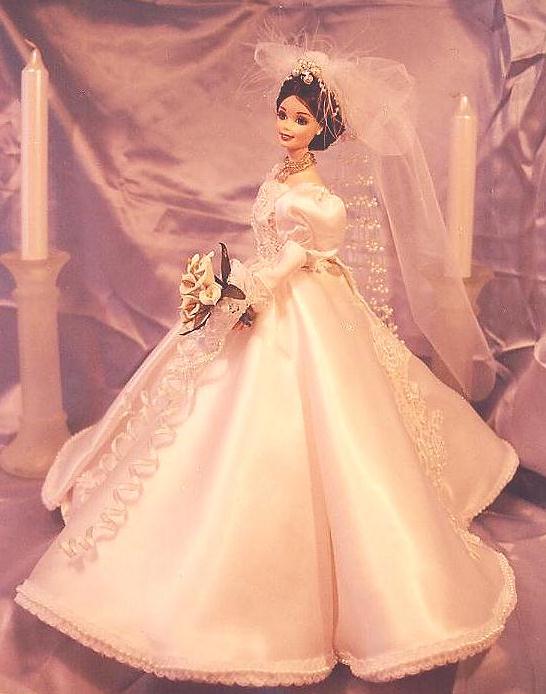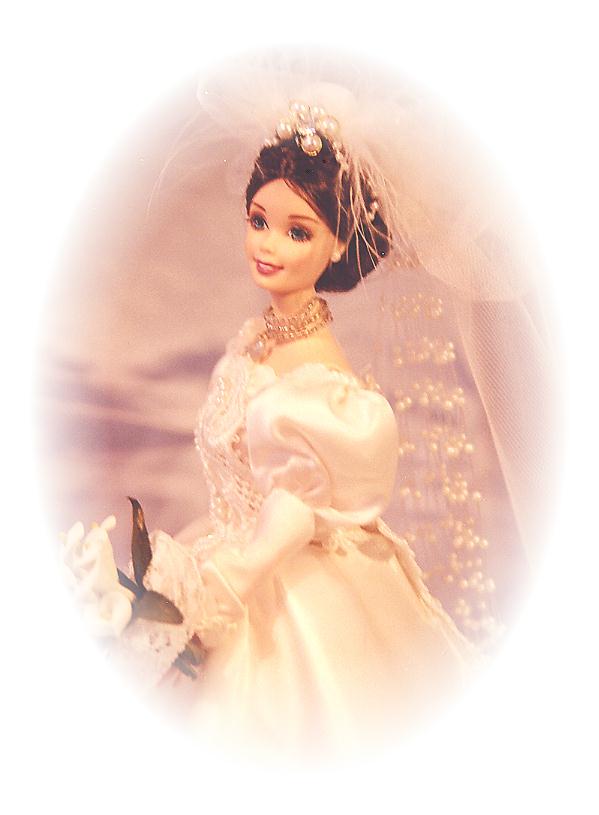 |
 |
 |
 |
 |
 |
 |
|
| Edwardian Bride |

|
This bride wears a gorgeous, formal gown in the style of the Late Victorian-Early Edwardian period--about the 1890's. The
pictures truly cannot do justice to the detail of the gown! The gown itself is made of lush, pearly white satin (the lighting
in the pictures makes it look a bit off-white, but in reality it is quite bright).
White for wedding gowns became popular after Queen Victoria wore a white gown at her wedding to Prince Albert in 1840.
Before that time, and after in the case of less well-to-do brides who couldn't afford an extra dress in impractical white,
women simply wore their best, Sunday dress with the addition of a veil. At the time, the color white was considered a symbol
of joy, making it appropriate for a day of joyful celebration (interestingly,in some cultures white symbolizes the opposite
of joy--mourning).
| Edwardian Bride |

|
The bridal bouquet is a large nose-gay of calla lilies: in the Victorian language of flowers, calla lilies stood for "magnificent
beauty." The bouquet is trimmed with white lace and a cascade of white and silver ribbon spirals.
|
 |
|
 |
 |
 |
 |
 |
 |
 |
|
| Edwardian Bride |

|
This bridal ensemble comes in three separate and removable parts: bodice, overskirt/underskirt combination, and petticoat.
The skirt is extremely full, falling in extravagant folds of shining, white satin; the overskirt is split up the front to
show off the underskirt, which is adorned with a beautiful, floral lace medallion in front.
The bodice has leg-o-mutton sleeves: full poufs at the shoulder, then fitting trimly to the arms from just above the elbow
to the wrist. The wrists and shoulders are trimmed with a rose and tulle twisted braid. The bodice itself is close-fitting
with a modest, straight neckline and a dropped, pointed waist. Another rich floral lace medallion covers the front and wraps
around to the back (which closes with a velcro closing).
It was considered good taste for bridal jewelry to be simple in design and in number, but wealthy brides did not stint on
quality--pearls and diamonds were favored for use with white dresses. One of the bride's pieces of jewelry was often a gift
from the groom, while others might be family heirlooms.
This doll wears both "pearls" and "diamonds" or crystal. She has simple pearl earrings and a rope
of pearls twined through her plaited coronet of shiny brown hair. Her bridal headdress is composed of a large tulle bow that
trails down the back in two long veils between which can be seen a "waterfall" of pearls. The tulle veil is attached
to the doll's chignon held on by a "pearl" hat-pin. In front a wispy spray of white "ostrich" feathers
frames a tiara "flower" with pearl petals and diamond center. Around her neck is a fashionable Edwardian-style
multi-strand crystal choker, with a crystal heart pendant accented with a large "diamond"--perhaps the gift of her
groom. Even the bride's white shoes are adorned with "diamond" buckles.
|
|
 |
|
|
|
 |
 |
 |
|
 |
 |
 |
|
The doll used in this design is the collector's edition "Swan Queen" ballerina from the Swan Lake collection.
She has beautiful porcelain skin, kissed with pink, and large blue eyes with real lashes. Her lips were re-painted an elegant
mauve and sealed with gloss acrylic sealant. Her shining brown hair, parted smoothly in the middle, with a braided coronet,
and chignon in back was already appropriate to the design and was unchanged--simply enhanced by the headdress.
|
|
 |
 |
 |









